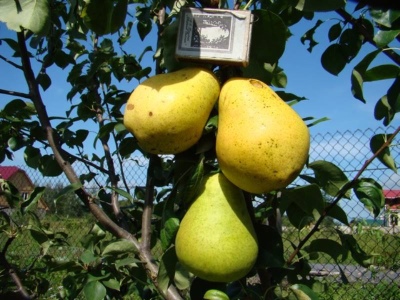
- Authors: Falkenberg E. A., Mazunin M. A., Putyatin V. I. (FGBNU Ural Federal Agrarian Research Center of the Ural Branch of the Russian Academy of Sciences)
- Appeared when crossing: seedling of the Ussuri pear 41-15-9 x Favorite Klapp
- Year of approval: 2002
- Fruit weight, g: 110-130
- Ripening terms: autumn
- Fruit picking time: September 5-10
- Appointment: dining room
- Growth type: vigorous
- Yield: high
- Height, m: until 6
Larinskaya autumn pear is an excellent option for supplying fresh fruit for the winter. The fruits, taken in autumn, reach ideal ripeness after a month of storage in a cool place. The table variety is intended for fresh consumption, for cooking compotes, juices, preserves, jams, preserves, as well as for confectionery.
Breeding history
The culture was bred at the Ural Federal Agrarian Research Center of the Ural Branch of the Russian Academy of Sciences. Falkenberg E.A., Mazunin M.A., Putyatin V.I. The pear was registered in the state register of breeding achievements in 2002.
Description of the variety
A vigorous (up to 6 m) tree has a crown of medium density and irregular shape. Skeletal curved branches extend from the trunk at an angle of almost 90 degrees. Curved and thick arcuate shoots are covered with brown bark with slight pubescence. Dark green, large, wide leaves have a smooth surface and are attached to thick, medium-length petioles. The pear blooms with large and fragrant small chalky white flowers with oval petals, collected in simple inflorescences. Large stipules are lanceolate. Ovaries are formed on simple and complex ringlets, in fruit sacs.
Fruit characteristics
Short pear-shaped fruits of medium size (110-130 g) in the period of removable maturity are colored in green tones, changing to a light yellow palette with a pink blush after the onset of consumer ripeness.
Taste qualities
The creamy pulp has a dense texture, it is juicy and sweet, supplemented with a slight sourness, but without astringency. The fruit, attached to an oblique, thick and short stalk, is covered with a smooth skin with numerous and clearly visible gray subcutaneous punctures.
Composition:
- sugar - 9.7%;
- dry matter - 13.8%;
- titratable acids - 0.8%.
The evaluation of the tasting committee is 4.5 points out of 5 possible. The fruits have good keeping quality and remain juicy and attractive until November.
Ripening and fruiting
The early-fruiting (5 years after planting) variety belongs to the autumn type: harvesting begins in the first decade of September. Fruiting is regular.

Yield
Larinskaya is distinguished by a high yield of the harvest: on average, up to 46 kilograms are harvested from one tree, and 83 centners from 1 hectare.
Growing regions
The variety is adapted for the Ural region.
Self-fertility and the need for pollinators
Unfortunately, Larinskaya is considered partially self-fertile, and is not able to give a full-fledged harvest without the proximity of pollinating varieties with the same flowering time.These include Severyanka and Skazochnaya.
Landing
For planting, choose sunny areas with good protection from drafts and winds. The optimal time is spring, so that the plant has time to build up the root system and get stronger before wintering. If the seedling was purchased in the fall, then it is better to dig it in an inclined position until spring. The soil should be fertile, loose, pear does not like loam. In this case, the soil must be ennobled by the introduction of river sand, humus, compost.
The size of the planting pit is 80x80x110 cm. A drainage layer is laid at the bottom of the pit, the fertile soil is additionally enriched with organic matter, wood ash, and complex mineral fertilizers. Simultaneously with filling the drainage, a support for a delicate plant is installed. After that, part of the fertile land is poured with a mound, over which the roots of the plant are distributed. The seedling is covered with earth, making sure that the root collar remains above the surface.


Growing and care
After planting young seedlings, caring for them is no different from the traditional one. Young plantings need regular and abundant (20-30 l) watering. Second-year trees are watered much less often: no more than 1 time in 30 days. Adult pears do without additional irrigation. Fertilization is carried out simultaneously with watering, which contributes to their rapid assimilation by the root system, and adult trees are processed by the foliar method. Larinsky pear reproduces by grafting and budding on seedlings of the Ussuri pear, no shedding is observed.



Disease and pest resistance
The pear is characterized as a tree with high resistance to pear gall mite, as well as to diseases such as scab, rustiness, fire blight. Despite these declared characteristics, it should be remembered that not a single garden tree is able to resist a fire blight 100%, no matter if it is a pear, an apple tree or something else. Regular examinations of the crown and bark are mandatory in any case, as is therapy for the entire garden if the first signs are found.

Like any other fruit trees, the pear needs protection from various diseases and pests. When planting a pear on your site, you need to know in advance what diseases you should beware of.To successfully carry out the struggle, it is necessary first to correctly identify the cause of the problem. It is important to distinguish signs of disease from manifestations of the presence of insects, mites, caterpillars and other types of pests.
Resistance to soil and climatic conditions
An adult tree tolerates heat well, copes well with drought, and has good frost resistance.





































































